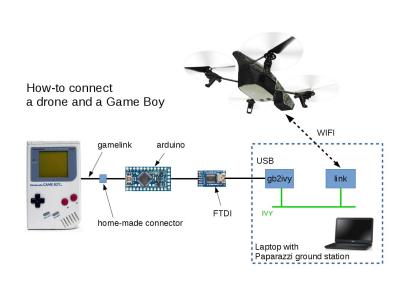How many grown-up hardware hackers whiled away their youth playing Tetris or Mario on their Game Boy? Fond memories for many, but unless you are lucky your Game Boy will probably be long gone. Not for [Gautier Hattenberger] though, he had an unexpected find at his parents’ house; his Game Boy Classic, unloved and forgotten for all those years. Fortunately for us his first thought was whether he could use it as a controller for a drone, and better still he’s shared his work for all of us to see.

Back in the day a would-be Game Boy hacker would have been deterred by Nintendo’s legal defences against game piracy, but with the benefit of a couple of decades the handheld console’s hardware is now an open book. Unfortunately for [Gautier], he seems to be the first to use one as a flight controller, so he had to plough his own furrow. His Game Boy Game Link serial port feeds an Arduino/FTDI combination that converts Game Link to USB, which is then sent to his laptop on which a small piece of software converts them to commands for the drone through the Paparazzi UAV framework.
All his code is in a GitHub repository, and he’s posted a video of his work which you can see below the break. For a child of the early ’90s, the mere thought that their handheld console could do this would have been mindblowing!
Perhaps unsurprisingly most of the Nintendo Game Boy hacks we’ve featured over the years have had a gaming flavour, so this is the first Game Boy flight controller. The hack we desperately wanted in about 1991 was a Game Boy oscilloscope cartridge, and though it seems that’s another one yet to be conquered we have featured the reverse: an oscilloscope as Game Boy display.
Thanks [Piotr] for the tip.















I have an oscilloscope cartridge for my Game Boy.
Elektor mag ran on in about 2000. A quick search for GBDSO will find it
Sadly my Game Boy has suffered terminal eprom corruption and no longer boots :(
I will buy it
They also made some prototype board thing with just a eeprom and some io extended. Got the schematics. Your GBDSO thing would be SO sweet to have. Somone could fix it :D
The UK version of the article (ive read the Dutch one back in the day… dint had the money)
http://www.reinerziegler.de/gbdso_uk.pdf
ow, https://www.elektormagazine.com/magazine/elektor-200011/16874
ive build this thanks to elector: https://www.elektormagazine.com/magazine/elektor-200101/16949
anyway, the internet is full of Gameboy projects so anyone could build a DSO now or just some cardrige
I thought about this back in the 90’s when I was a kid. (Never done though, I was a wee bit young at the time.)
Nice to know I’m not the only one who thought of it.
The Game Boy Link port is just a serial port?
Yes. In fact, there was another project featured here where someone was evolving pokemon by controlling this serial port with a microcontroller(some pokemon need to be traded to they can evolve).
Thanks for the reply. Yeah I was thinking exactly of this sort of Man-In-The-Middle or replay-attacks when I asked :D
Not even that, really. It’s not RS-232 or anything. It’s simply bit-banged, in software. There’s a data line and I think a clock, and that’s about it, far as I remember. The docs are out there. So you can use whatever format you like, I dunno if games used a particular bit of library code, but there’s no need for them to, though of course it’d be convenient.
The DMG is just a very very slow (8kbit/sec) SPI port. The GBC is still just a SPI port, but at least it’s not bog slow (up to 2¹⁹kbit/sec).
It didn’t become a GPIO port until the GBA.
2^19 kbit/s ??? That would be around 500Mbit/s. That seems not possible for the time.
Gameboy as an oscilloscope has been done already. I remember reading about it in Elektor. Google search confirms there have been others.
https://www.elektor.com/gameboy-digital-sampling-oscilloscope-990082-91
Interesting but it would be way cooler if they made a custom cart that actually issued the commands to the UAV.
You can get “backup” carts for the GB, they’ve been available since the GB was a current, viable console. There’s a small amount of homebrew. A popular one is LSDJ, a music tracker. My friend uses it on a “Drag ‘n’ Derp” cart. It’s a cart that’s designed to be easier than the others, needs no special software or parallel port hardware or anything. You just plug it into USB and it acts as a hard drive, copy the ROM file to it, then plug it in and off it goes.
Of course such utility doesn’t come cheap, but it’s the most reliable one available. Older carts don’t work on modern versions of Windows, with the Chinese software currently available. I suppose you could try reverse-engineering.
dat latency
Effectively all the person did was turn a Gameboy into a USB joypad…
Let me know when it’s a custom, self contained cart.
It could be a lot more than that if you are running GBBasic on a flash cart with RAM… It could be the greatest terminal your arduino, teensy, raspi, or whatever has ever seen. Set GBBasic to graphical mode and you could draw maps on the screen in real time showing where you are with a Pi Zero connected to a GB and to a cheap 3v3 serial GPS unit.